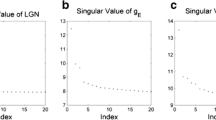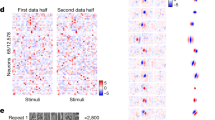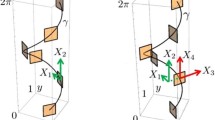Abstract
In this paper, we extend our framework for constructing low-dimensional dynamical system models of large-scale neuronal networks of mammalian primary visual cortex. Our dimensional reduction procedure consists of performing a suitable linear change of variables and then systematically truncating the new set of equations. The extended framework includes modeling the effect of neglected modes as a stochastic process. By parametrizing and including stochasticity in one of two ways we show that we can improve the systems-level characterization of our dimensionally reduced neuronal network model. We examined orientation selectivity maps calculated from the firing rate distribution of large-scale simulations and stochastic dimensionally reduced models and found that by using stochastic processes to model the neglected modes, we were able to better reproduce the mean and variance of firing rates in the original large-scale simulations while still accurately predicting the orientation preference distribution.







Similar content being viewed by others
References
Antoulas, T. C. (2005). Approximation of large-scale dynamical systems. Philadelphia: SIAM.
Badel, L., Lefort, S., Brette, R., Petersen, C. C., Gerstner, W., & Richardson, M. J. (2008a). Dynamic I–V curves are reliable predictors of naturalistic pyramidal-neuron voltage traces. Journal of Neurophysiology, 99, 656–666.
Badel, L., Lefort, S., Berger, T. K., Petersen, C. C., Gerstner, W., & Richardson, M. J. (2008b). Extracting non-linear integrate-and-fire models from experimental data using dynamic I–V curves. Biological Cybernetics, 99, 361–370.
Broder, J., Majumder, A., Porter, E., Srinivasamoorthy, G., Keith, C., Lauderdale, J., et al. (2007). Estimating weak ratiometric signals in imaging data. I. Dual-channel data. Journal of the Optical Society of America. A Optics, Image Science and Vision, 24, 2921–2931.
Cai, D., Rangan, A. V., & McLaughlin, D. W. (2005). Architectural and synaptic mechanisms underlying coherent spontaneous activity in V1. Proceedings of the National Academy of Sciences of the United States of America, 102, 5868–5873.
De Valois, R. L., Albrecht, D. G., & Thorell, L. G. (1982). Spatial frequency selectivity of cells in macaque visual cortex. Vision Research, 22, 545–559.
Eckart, C., & Young, G. (1936). The approximation of one matrix by another of lower rank. Psychometrika, 1, 211–218.
Everson, R. M., Prashanth, A. K., Gabbay, M., Knight, B. W., Sirovich, L., & Kaplan, E. (1998). Representation of spatial frequency and orientation in the visual cortex. Proceedings of the National Academy of Sciences of the United States of America, 95, 8334–8338.
FitzHugh, R. (1961). Impulses and Physiological States in Theoretical Models of Nerve Membrane. Biophysical Journal, 1, 445–466.
Hodgkin, A., & Huxley, A. (1952). A quantitative description of membrane current and its application to conduction and excitation in nerve. The Journal of Physiology, 117, 500–544.
Hubel, D. H., & Wiesel, T. N. (1962). Receptive fields, binocular interaction and functional architecture in the cat’s visual cortex. The Journal of Physiology, 160, 106–154.
Huys, Q. J., & Paninski, L. (2009). Smoothing of, and parameter estimation from, noisy biophysical recordings. PLoS Computational Biology, 5, e1000379.
Huys, Q. J., Ahrens, M. B., & Paninski, L. (2006). Efficient estimation of detailed single-neuron models. Journal of Neurophysiology, 96, 872–890.
Ikeda, S., & Toyama, K. (2000). Independent component analysis for noisy data—MEG data analysis. Neural Networks, 13, 1063–1074.
Jolivet, R., Lewis, T. J., & Gerstner, W. (2004). Generalized integrate-and-fire models of neuronal activity approximate spike trains of a detailed model to a high degree of accuracy. Journal of Neurophysiology, 92, 959–976.
Kistler, W., Gerstner, W., & van Hemmen, J. L. (1997). Reduction of the Hogkin-Huxley equations to a single-variable threshold model. Journal of Neural Computation, 9, 1015–1045.
Knight, B. W., Omurtag, A., & Sirovich, L. (2000). The Approach of a Neuron Population Firing Rate to a New Equilibrium: An Exact Theoretical Result. Journal of Neural Computation, 12, 1045–1055.
Lorenz, E. N. (1956). Empirical orthogonal functions and statistical weather prediction. In: Scientific Report. Cambridge, MA: Statistical Forecasting Project, MIT.
Lumley, J. L. (1967). The structure of inhomogeneous turbulent flows. In A. M. Yaglom & V. I. Tatrski (Eds.), Atmospheric turbulence and radio wave propagation. Moscow: Nauka.
Makeig, S., Bell, A. J., Jung, T.-P., & Sejnowski, T. J. (1996). Independent component analysis of electroencephalographic data. Advances in Neural Information Processing Systems, 8, 145–151.
McKeown, M. J., & Sejnowski, T. J. (1998). Independent component analysis of fMRI data: examining the assumptions. Human Brain Mapping, 6, 368–372.
McLaughlin, D., Shapley, R., Shelley, M., & Wielaard, D. J. (2000). A neuronal network model of macaque primary visual cortex (V1): orientation selectivity and dynamics in the input layer 4Calpha. Proceedings of the National Academy of Sciences of the United States of America, 97, 8087–8092.
Mitra, P. P., & Pesaran, B. (1999). Analysis of dynamic brain imaging data. Biophysical Journal, 76, 691–708.
Nagumo, J. S., Arimoto, S., & Yoshizawa, S. (1962). An active pulse transmission line simulating nerve axons. Proceedings of the IRE, 50, 2061–2070.
Percival, D., Walden, A. (1993) Spectral analysis for physical applications. Cambridge University Press.
Pillow, J. W., Shlens, J., Paninski, L., Sher, A., Litke, A. M., Chichilnisky, E. J., et al. (2008). Spatio-temporal correlations and visual signalling in a complete neuronal population. Nature, 454, 995–999.
Rangan, A. V., Cai, D., & McLaughlin, D. W. (2005). Modeling the spatiotemporal cortical activity associated with the line-motion illusion in primary visual cortex. Proceedings of the National Academy of Sciences of the United States of America, 102, 18793–18800.
Rudolph, M., & Destexhe, A. (2003). Characterization of subthreshold voltage fluctuations in neuronal membranes. Neural Computation, 15, 2577–2618.
Rudolph, M., & Destexhe, A. (2004). Inferring network activity from synaptic noise. Journal of Physiology, Paris, 98, 452–466.
Salinas, E., & Sejnowski, T. J. (2000). Impact of correlated synaptic input on output firing rate and variability in simple neuronal models. Journal of Neuroscience, 20, 6193–6209.
Shelley, M., & McLaughlin, D. (2002). Coarse-grained reduction and analysis of a network model of cortical response: I. Drifting grating stimuli. Journal of Computational Neuroscience, 12, 97–122.
Shelley, M., McLaughlin, D., Shapley, R., & Wielaard, J. (2002). States of high conductance in a large-scale model of the visual cortex. Journal of Computational Neuroscience, 13, 93–109.
Sirovich, L. (1987). Turbulence and the dynamics of coherent structures, Parts I–III. Quarterly of Applied Mathematics, 45, 561–590.
Sirovich, L., & Rodriguez, J. D. (1987). Coherent structures and chaos: A model problem. Physics Letters A, 120, 211–214.
Sornborger, A., Sirovich, L., & Morley, G. (2003). Extraction of periodic multivariate signals: mapping of voltage-dependent dye fluorescence in the mouse heart. IEEE Transactions on Medical Imaging, 22, 1537–1549.
Sornborger, A., Yokoo, T., Delorme, A., Sailstad, C., & Sirovich, L. (2005). Extraction of the average and differential dynamical response in stimulus-locked experimental data. Journal of Neuroscience Methods, 141, 223–229.
Spitzer, H., & Hochstein, S. (1985). Simple- and complex-cell response dependences on stimulation parameters. Journal of Neurophysiology, 53, 1244–1265.
Tao, L., & Sornborger, A. T. (2010). Dimensionally-reduced visual cortical network model predicts network response and connects system- and cellular-level descriptions. Journal of Computational Neuroscience, 28, 91–106.
Tao, L., Shelley, M., McLaughlin, D., & Shapley, R. (2004). An egalitarian network model for the emergence of simple and complex cells in visual cortex. Proceedings of the National Academy of Sciences of the United States of America, 101, 366–371.
Tao, L., Cai, D., McLaughlin, D. W., Shelley, M. J., & Shapley, R. (2006). Orientation selectivity in visual cortex by fluctuation-controlled criticality. Proceedings of the National Academy of Sciences of the United States of America, 103, 12911–12916.
Wang, X. J., & Buzsaki, G. (1996). Gamma oscillation by synaptic inhibition in a hippocampal interneuronal network model. Journal of Neuroscience, 16, 6402–6413.
Wielaard, D. J., Shelley, M., McLaughlin, D., & Shapley, R. (2001). How simple cells are made in a nonlinear network model of the visual cortex. Journal of Neuroscience, 21, 5203–5211.
Xu, J., Sornborger, A. T., Lee, J. K., & Shen, P. (2008). Drosophila TRPA channel modulates sugar-stimulated neural excitation, avoidance and social response. Nature Neuroscience, 11, 676–682.
Acknowledgments
Louis Tao would like to acknowledge the hospitality of the University of Georgia Department of Mathematics and Andrew Sornborger would like to acknowledge the hospitality and support of the Center for Bioinformatics of the College of Life Sciences of Peking University.
This work was supported by NIH NIBIB 005432 (ATS), NIH NINDS 070159 (ATS) and the National Basic Research Program of China (973 Program 2011CB809105) (LT).
Author information
Authors and Affiliations
Corresponding authors
Additional information
Action Editor: David Golomb
Electronic supplementary material
Below is the link to the electronic supplementary material.
ESM 1
(DOC 17 kb)
Rights and permissions
About this article
Cite this article
Tao, L., Praissman, J. & Sornborger, A.T. Improved dimensionally-reduced visual cortical network using stochastic noise modeling. J Comput Neurosci 32, 367–376 (2012). https://doi.org/10.1007/s10827-011-0359-3
Received:
Revised:
Accepted:
Published:
Issue Date:
DOI: https://doi.org/10.1007/s10827-011-0359-3




